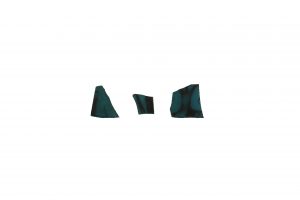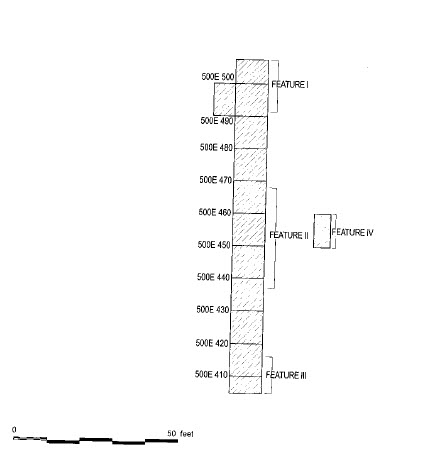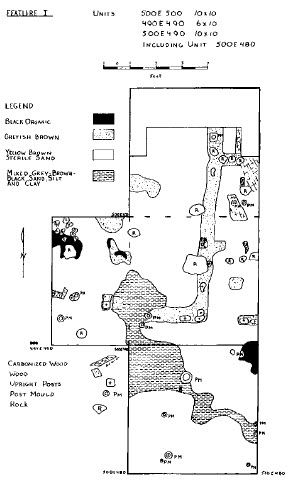Peter’s Findings: Structures
The 1965 excavations centred on a ten foot (3 m) wide test trench, extending north–south from front (south) to north through the near centre of the enclosure.
Four major features were uncovered. The remains of a charred building were the most significant and rich deposit on the site. The upper stratum was disturbed with a large quantity of loose limestone fragments among which were found nails, glass beads and metal fragments. With increasing depth, intact structural elements and many more artifacts were exposed. Many artifacts were found among the remnants of the structure, nails making up the greatest percentage.

Remnants of blue glass with black design, likely from a window found during excavations in the 1980’s.
The stratum that was most likely the original ground level was at a depth of around 12 inches although this was variable. This level yielded a significant number of artifacts along with evidence of fire, such as pieces of carbonized wood, fragments of Wendat pottery that had been melted by the heat, and nuggets of smelted bronze. An interesting grey-green cinder or slag-like material, which seemed to have high silica content, lay with its shiny convoluted surface down as well as a light brown silt-covered surface ─ obviously a product of the fire and upon melting deposited at ground level where it hardened into slag-like fragments.
Potential door-ways were indicated by intervals in a continuous twenty foot long construction trench and two hinges and several clenched nails, all of which could have been used on doors, were found at a depth of between eight and ten inches. Several nails were found among the stones. Much more excavation would be necessary to ascertain with any certainty the nature and function of the building represented by these remains. The main value of the feature was in showing that sufficient evidence of structural and artifact deposits had survived and that a full comprehensive excavation would be profitable.
Associated with this structure was a sheet of very heavy gauge iron stock that measured nine by four inches with a thickness of .15 inch. It’s fairly regular shape suggests that bulk iron stock was shipped to Sainte Marie I in this form for use in forging nails and other materials and brought to Sainte Marie II.



